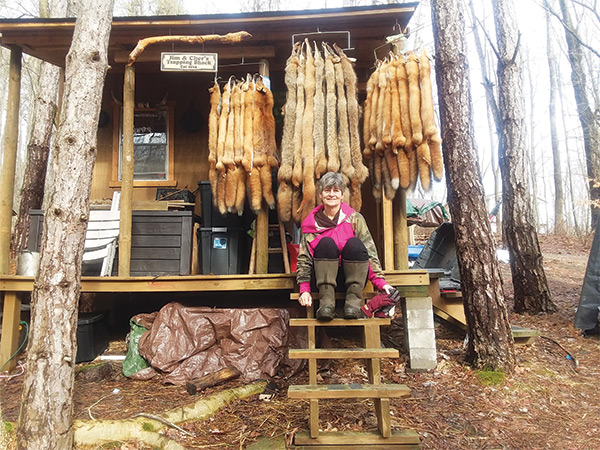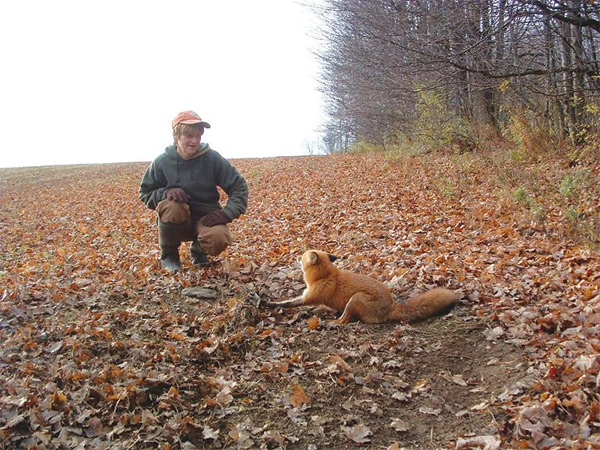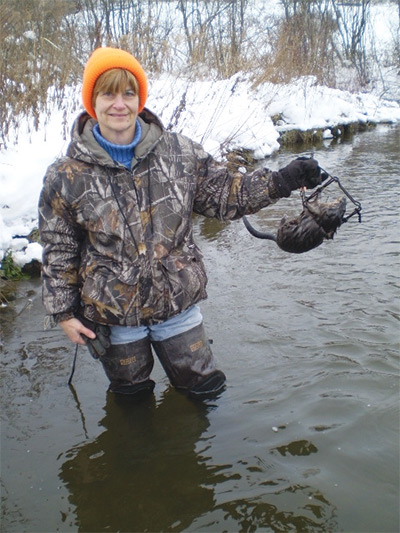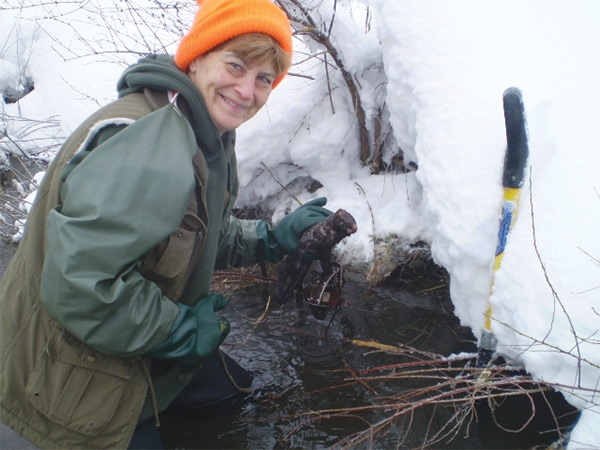 Trapping With The Better Half
Trapping With The Better Half
By Jim McCarrick

It was my wife Cheryl’s first season joining me on a water trap-line, her first season as a trapper. After receiving a beaver complaint and calling on the landowner, we agreed that we would trap the beaver at no charge if he allowed us to stretch a muskrat and mink line on the trout stream that ran through several hundred acres of his property. We loaded up a plastic sled full of gear packs and began the drag in more than a foot of snow, making our way to the stream.
The air was cold, but the stream was wide open and at normal levels, perfect to get a line in. We talked about the best direction to head. Without thinking, I shouldered a pack and stepped into the waist deep water wearing my chest waders. Then I heard a loud shriek behind me and turned to see Cheryl standing in the water. She was wearing hip boots. What was waist deep on me was almost chest deep on her. In her eagerness to participate, she tried to laugh it off while emptying her boots and suggested we keep moving. She felt fine, she said. But I knew better. I told her to leave all her gear in the sled, immediately get to the Jeep, get her boots off and get the Jeep’s heater blowing hot.
I watched her walk across the long field, waited to see exhaust coming out of the Jeep’s tail pipe and an “all ok” wave before I felt comfortable enough to get a few sets in, so we’d have something to check the following day returning to finish the line.
Cheryl apologized all the way home, saying she’d “ruined the day.” I responded with my own apologies. It was on me to make sure she understood the limitations of her hip boots, to ensure her safety, point out where she should enter the water. Anyone who has fished a clear water trout stream knows how deceiving depth can be. I’d been doing this most of my life, this was her first year trapping. I should have been more observant and aware.
* * *
Cheryl and I met at the prime age of 50, both with previous lives with others. We quickly realized we were meant to be together, but we couldn’t have been more different. I have been an avid outdoorsman — fishing, hunting, trapping, canoe camping, snowshoeing and cross-country skiing — since I was a youngster. She’d never seen a trap, fired a gun, or cast a lure. Her idea of camping in her previous life was a park model RV in a “glamping” resort. How was this going to work?
Her first exposure to trapping was when we began dating. I told her I’d be busy the next few days since I was off work and wanted to run a muskrat and mink line on a few streams. She asked if she could tag along. Yeah, I said, you can walk the bank while I wade in the streams running the traps.
She met me the next morning at the agreed upon spot and after exchanging hellos, I handed her an empty canvas pack. “What’s this for?” she wondered.
I told her if I caught any muskrats I’d toss them up the bank to her and she could carry them in the pack as she followed along.
“Great,” she said.
We discovered the muskrats were moving that night. She watched everything I did and started to see and understand the locations that yielded rats. The first stream was loaded, and she was handling that pack fine with half a dozen rats in it. Soon we were up to 14 muskrats and a mink, and she dragged the pack along the ground, determined to keep up with me.
I was more than a little nervous that I was about to chase this lovely lady off. But my thoughts quickly changed when we took a break along the stream.
Cheryl looked at the stream. It narrowed, vegetation closing in, creating an opening just big enough for a 110 Conibear. “I think that would be a good spot,” she said.
So, we set a trap there. Next day as she followed along, she couldn’t wait to get to that set. It held a nice rat, and she was hooked — or at least I’d hoped she was.
* * *
Soon after, she decided on her own that if she was ever going to see her new boyfriend (hopefully husband) she was going to have to learn something of the activities I had a passion for, learning for herself what was so appealing about them.
She took to fishing easily and developed a passion of her own for that. She learned to shoot, got her hunting license, and joined me in deer stands with her own rifle. She loved the excitement of being in the deer woods with me, but never developed the self-confidence to humanely shoot a deer. When a deer would approach, she’d say, “You take him.” But she loves venison, butchering our own harvest, and trying new recipes. And she still enjoys sitting in the tree stand during bow season with a camera, savoring autumn — and its critters.
She also signed up for the required trapping course, passed it, and got her trapping license. This was the one pursuit I thought it most unlikely she’d take to. Yet, looking back, 15 years later, she’s not missed a trapping season with me. In fact, Cheryl enjoys trapping more than any other outdoor activity.
Spoiler alert: we got married. Then we purchased a place together a couple hours south of where I’d previously trapped. I had to start over, securing permissions, locating water spots and several nice farms. Armed with her own trapping license, Cheryl practiced setting traps, including punching out dirt-hole sets in our yard. She took part in the dye and wax process, looked through trapping catalogs for gear, and fought with me over who got first dibs on the trapping magazines when they hit the mailbox. It was a blast seeing her learning this art. She was full of questions and excitement. I’m not sure who enjoyed her transformation more.
When canine season opened, we hit the farms, doing well on red fox and a few coyotes. At first, she just watched and learned, then gradually started putting in her own sets. We would set three traps at each location, two being my sets, one hers. Hers were hitting as often as mine. We also took coons, possums and the occasional skunk.
It didn’t end on the line; she insisted on doing her share of skinning and fleshing. We’d come home where we had two gambrels hung and away we’d go. She was meticulous, always afraid of “ruining the fur.” Although it took her a while, her finished product was perfect. Like anyone, her first few weren’t flawless. When we sold those pelts, she told the fur buyer of her struggles skinning around the head, and of her journey to become a trapper. He gave her top dollar on those foxes because he was so impressed by a middle-aged woman learning to trap.

During our second season trapping together, my day job delayed me from our start date. Not to be deterred, Cheryl announced she would run her own trapline for a week. She wanted to prove she could do it herself.
She chose the 600-acre farm a mile from home. It had no tractor paths or other drive-in access, so she shouldered a pack basket and hiked her way through it, making 10 sets on the farm.
Her first night resulted in just one possum. She clearly felt a bit defeated, but stuck with it, and by the end of the week I came home to find a half-dozen foxes drying on stretchers. She was one proud lady, with an even prouder husband.
As she gained more experience, we developed a system for our trapping to make it efficient — to get as many traps in as we could in the shortest possible time. Setting three traps at each set location, we’d exit the truck, grab the gear, pointing out to each other three spots. The next thing you know we’re on our knees punching out the sets. I’d set and bed the trap, which includes driving in the cable stake and sifting the dirt over the set. She’d bait and lure the holes, adjust backing if required, hit the backing with fox urine, place some guide sticks, all while I prepared what we’d need for the next location back at the truck.
When we had a catch, I’d dispatch the animal and re-make the set. She’d haul the animal to the truck, grab her lure/bait kit, and put the goodies back on the set. We moved fast. No words or directions were necessary; a well-oiled machine built on trust and confidence in each other.
We were hobby trappers — not really interested in big numbers — but we’d usually have 30 to 50 sets soaking per night. With no goals to live up to, if the weather went south, as it often did here in western New York’s snowbelt, we’d snap off the traps and wait the weather out. Or we’d pull the sets and spend our time deer hunting or steelhead fishing. We’d measure our success in the quality of time together, pursuing something we both loved.
When water trapping, things were a bit different. Standing in 38-degree water was not Cheryl’s idea of a good time. She’d get into the water when required, but preferred solid ground. Hers was a supporting role, following along, handing me what I needed. When I asked for two 110s, or a couple 33s; she’d deliver the traps and a couple stakes, then continued along the stream scouting for locations while I made the sets.
Coming out of a swamp or stream with a couple beavers, a handful of rats and maybe a coon or mink, she always carried her share. She skinned them later right alongside me. As far as I was concerned, I’d have been perfectly happy if she were just there cheering me on. Anything else was a bonus.

Over the years, we’ve had some great days and seasons on the line. We’ve also faced many challenges, including bad weather, competition from other trappers, muddy catches, health issues, poor fur prices, and family commitments. But the good far outweighs the bad.
That’s usually how it works with trapping. There’s nothing like coming home after a long day on the line and having someone to share fur shed duties — although she cuts out early to get dinner cooking; which I certainly appreciate.
Have I mentioned how lucky I am?
Cheryl is the one flipping canines on the boards, brushing them out when they come off, making sure they look pretty for the sale. She enjoys sitting in the evening, relaxing and discussing the day’s catches, the misses, the things we saw, or the weather.
We rise together with the morning alarm. Cheryl fixes a thermos of coffee, a snack for out on the line, and checks the weather so we can both make informed decisions about the day.
Yeah... I can’t imagine a better partner.
More women are getting into trapping. Some are getting involved with their spouses and children. Others are discovering trapping on their own.
It’s a step in the right direction. One of the biggest growth markets in hunting is coming from women. Hopefully, this will continue in the trapping world. Because the more people we have involved in our outdoor sport, the more likely it will survive for our children.
I’ll fully attest to the benefits of having your spouse learning the art of trapping and joining you on the ‘line; more time together, working as a team, enjoying the outdoors as a couple. This only strengthens relationships.
* * *
It’s a bluebird day in late autumn, sun shining brightly with no wind. Cheryl and I finish the day with five foxes and two coyotes in the truck — a very good day. We’re on our main farm — our last stop. We pull the truck up to the top of a hill where a windmill lazily turns. From this perch we can see the entire 700 acres. The crop changes look like a patchwork quilt. An old railroad bed cuts through the middle of it. We sit on the truck tailgate peering out over the world, sharing coffee and a sandwich. We talk of the beauty of the landscape, both quietly grateful for the permission to be on this farm as if it were our own. I point out a red-tail hawk in the sky.
She gestures towards the fields. “Do you think we should set that cornfield edge where the two farm lanes meet?”
It’s like she read my mind.
